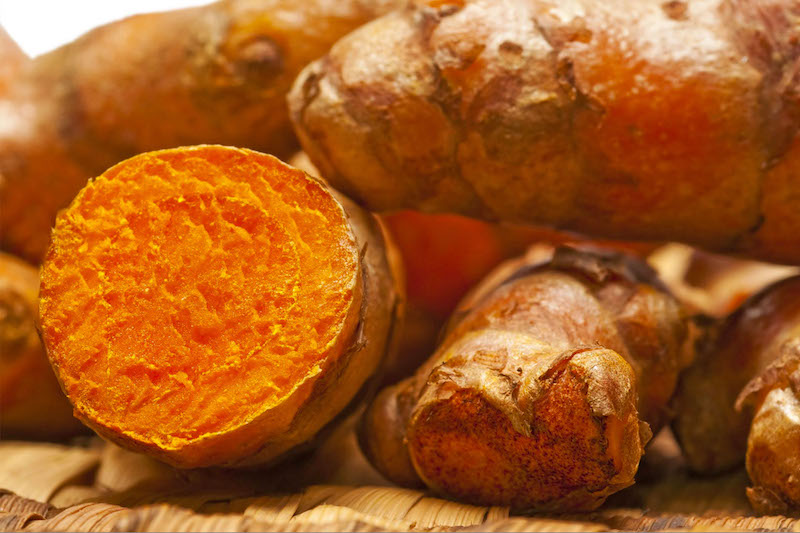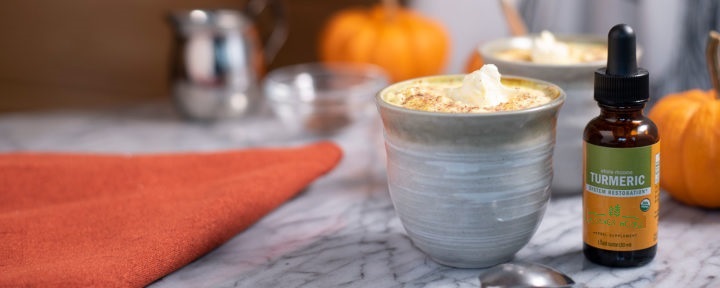Turmeric
Curcuma longa
Zingiberaceae - ginger family
- common turmeric
- Indian saffron
- yellow ginger
- pinyin: jiang huang
- Ayurveda: haridrā1.3
Details & Ingredients
BOTANICAL DESCRIPTION
Turmeric is an herbaceous perennial that can grow up to 3 feet in height.5 The plant has leaves that are lance-shaped and sheathed to the short leaf stalk.2,5 Its apical false flower is actually a modified leaf (bract) that is white to pink in color.5 Underneath are multiple funnel-shaped true flowers in a spike, surrounding the leaf stalk in a dense cylinder.5,8 The petals are pale yellow to white in color with two fang-like appendages that point downward into the flower, resembling an open mouth showing top incisors.5 Each flower emerges from a tubular bract that is white, white with light green tips, or light green.5 Its arillate seed is an ellipse-shaped capsule with 3 cells.5,8 The root is a main rhizome that is orange in the interior, oblong, and fleshy with small lateral roots.2,5 It has short-branched knobby secondary rhizomes that grow outwards from the main rhizome.2,5
rhizome
Prominent Constituents Reported in the Scientific Literature:
Volatile oils, curcuminoids and resins.2,5
TurkeyES
Promotes healthy liver and digestive function*
Used in Ayurveda for skin, digestive and liver support*
DID YOU KNOW?
Modern research and clinical studies began in India in the 1970s and it has become one of the most well-studied herbs.2
INFORMATION
Turmeric is indigenous to Asia, specifically Cambodia, China, India, Indonesia, Laos, Malaysia, the Philippines, Vietnam and Madagascar, off the African Coast.5 It has been introduced in Puerto Rico and Hawaii.9 The plant is widely cultivated in the tropics.5
The herb prefers humid tropical habitats and well-drained soil.2 The harvested rhizome is then broken up into segments.2
Usage of the herb was recorded in the first century A. D. by Dioscorides of Ancient Greece.7 It was noted by Dioscorides and Pliny the Elder, that the root made the saliva yellow once chewed.8 Therefore it was referred to as “al-kurkum”, meaning saffron in Arabic, referring to the color of the saffron crocus threads (stigma) that are used as a dye and spice.8 This led to its botanical genus name of Curcuma.9 Similarly in Sanskrit, the Ayurvedic name is Haridrā, meaning “yellow”.6 Around 657 A. D. in Traditional Chinese Herbalism, the herb was written about in the Xin Xiu Ben Cao materia medica by Su Jing.4 In the Central Pacific, its use has been documented in Hawaiian cooking and herbalism since 1922.9
The striking color also made it sought after for dyeing fabric.7 Turmeric as well as saffron have been used as dyes for the orange-yellow robes of Buddhist monks.7
- McGuffin M, Kartesz J. American Herbal Products Association’s Herbs of Commerce, 2nd ed. Silver Springs, MD: Publication of the American Herbal Products Association; 2000.
- Chevallier A. Encyclopedia of Herbal Medicine, 2nd ed. New York NY: DK Publishing Inc.; 2000.
- Bensky D, Gamble A. Chinese Herbal Medicine Materia Medica, Revised Ladangition, 2nd ed. Seattle WA: Eastland Press, Inc.; 1993.
- Chen J, Chen T. Chinese Medical Herbology and Pharmacology, 3rd ed. City of Industry, CA: Art of Medicine Press; 2012.
- World Health Organization. WHO Monographs on Selected Medicinal Plants, Vol. 1: Rhizoma Curcumae Longae. World Health Organization. 1999. Geneva, Switzerland.
- Pole S. Ayurvedic Medicine: The Principles of Traditional Practice, 2nd ed. London, England & Philadelphia, PA: Singing Dragon Press; 2013
- The Dabur Research Foundation, Dabur Ayurvet Limited. Major Herbs of Ayurveda. Ladanginburgh, England: Churchill Livingstone; 2002.
- Pereira J. The Elements of Materia Medica and Therapeutics, Vol. II, 3th American ed. London, England & Philadelphia, PA: Lea & Blanchard; 1854. Curcuma longa Accessed December 10, 2018.
Gallery




